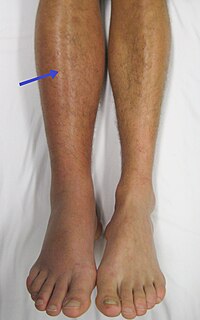
Photo from wikipedia
Coronavirus disease 2019 (COVID-19), caused by the severe acute respiratory syndrome coronavirus 2 (SARS-CoV-2), is a global public health concern and is characterized by an exaggerated inflammatory response that can… Click to show full abstract
Coronavirus disease 2019 (COVID-19), caused by the severe acute respiratory syndrome coronavirus 2 (SARS-CoV-2), is a global public health concern and is characterized by an exaggerated inflammatory response that can lead to a large variety of clinical manifestations such as respiratory distress, sepsis, coagulopathy, and death. While it was initially considered primarily a respiratory illness, different data suggests that COVID-19 can lead to a pro-inflammatory milieu and a hypercoagulable state. Several mechanisms attempt to explain the pro-coagulant state seen in COVID-19 patients, including increased fibrinogen concentration, different receptor binding, exhausted fibrinolysis, cytokine storm, and endothelial dysfunction. Some hematological parameters, such as elevated D-dimers and other fibrinolytic products, indicate that the essence of coagulopathy is massive fibrin formation. Moreover, elevated D-dimer levels have emerged as an independent risk factor for a worse outcome, including death, indicating a potential risk for deep vein thrombosis and pulmonary thromboembolism. Prophylactic anticoagulation is recommended in all in-patients with COVID-19 to reduce the incidence of thrombosis. Those with elevated D-dimer values or with a higher risk of developing thromboembolic events should be treated with higher doses of anticoagulant. Anticoagulation may not be enough in some circumstances, highlighting the need for alternative therapies. An understanding of the complex cross-talk between inflammation and coagulopathy is necessary for developing direct appropriate interventional strategies.
Journal Title: Medicine and Pharmacy Reports
Year Published: 2022
Link to full text (if available)
Share on Social Media: Sign Up to like & get
recommendations!